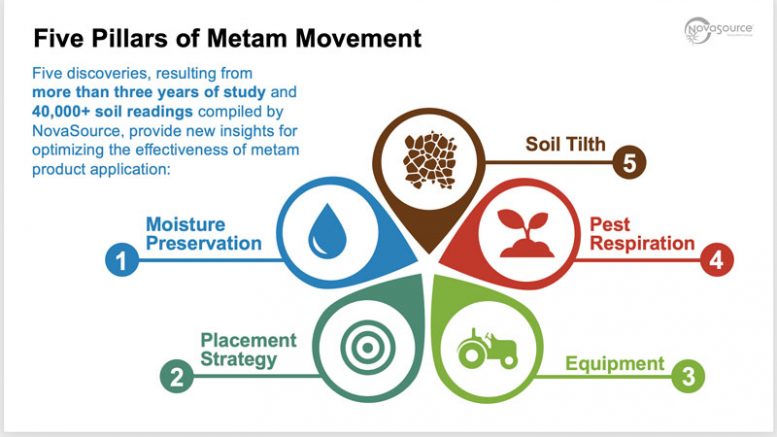40,000 Soil Readings, Five Takeaway Insights
By Bill Woodward, NovaSource North America
Today, many carrot growers are using the soil fumigants metam sodium and metam potassium more efficiently than ever for the suppression of weeds, disease and nematodes because of insights gained from a four-year study by NovaSource into how the products perform following application.
Now that more than 40,000 post-application soil sample readings have been collected and categorized, several assumption-busting revelations have been revealed. And a better understanding of the underground behaviors of these products is now guiding applicators to optimize metam applications.
This knowledge is enabling operators to maximize underground metam product exposure to pests and generate some highly favorable results.
Introducing an Underground Technology
In 2017, a presentation on the subject of soil fumigation by Dr. Steve Fennimore, a weed scientist from UC Davis, captivated attendee Kyle Coleman, director of marketing and commercial development at NovaSource. As Fennimore explained about his use of a photo-ionization detector to better understand fumigant location in soil, Coleman was inspired to try it out for himself.
“I had been working with metam products since 1999, but had no clue this equipment was available,” Coleman recalls. “I purchased a unit and made a call to a custom applicator to try it out. I just wanted to see how the technology worked. I had no idea what I was about to get myself into.”
Coleman’s first test was on a carrot field in Washington, and he and the grower were surprised by the results.
“The application was made by shanking at 12 inches, and after 48 hours, almost none of the fumigant was found in the top 6 inches. We were all startled by the findings,” Coleman says.
“We started to realize that if the product wasn’t moving as much as any of us had assumed, we’d need to prioritize the pests, be more specific about pest location and determine how to get the product where it needed to be,” he added.
Numerous adjustments were made to application rate, depth of application and soil moisture content over a two-year period before agronomists were completely satisfied with the placement of the product for maximizing results.
In the meantime, word of these findings began to spread, and Coleman found himself immersed in requests for insights.
“We’ve collected readings in nine states where metam products are used for different crops,” Coleman says. “I’ve seen a lot. I’ve seen single-level and dual-level placement, rototillers, drip application and chemigation. I’ve seen sweeps, shanks, nozzles and drop tubes in many configurations. I’ve been on soil that is so dry the dust shot up into my pant legs all over my socks with every step, and fields so muddy I could barely keep my balance. Every single application method creates a unique pattern, and the conditions in which the product is applied creates another layer of complexity.”
“If there were little variation, I would have stopped at a few thousand readings. Instead, we’ve collected and received more than 40,000 post-application soil sample readings from coworkers and fantastic cooperators from all over the country, and every one of them tells a story,” he says.
Common Themes Emerge
Since Coleman’s initial visit to that first field in 2017, this collection of data has revealed five main variables that can create significant differences in product effectiveness – often, when only minor adjustments to an application method are employed.
“When you look at all the information, the keys for optimizing the effectiveness of your metam soil fumigant application boil down to these primary new insights,” Coleman says.
He calls them “the five pillars of metam movement in soil.”
Moisture Preservation
If possible, maintain 80 percent moisture throughout the soil profile weeks before application up to the day of application. Moist soil delivers several benefits: submoisture helps facilitate metam movement; moist soil promotes respiration in an important pest like weeds; moisture in the soil helps maintain longer exposure times; and from a stewardship perspective, moisture helps reduce odor and the chance of off-gassing.
Placement Strategy
Compared to other fumigants, the vapor pressure of metam products is relatively low, so they simply don’t travel as far or as uniformly as applicators have assumed for many years. Sampling the soil to better understand your exact pest location is recommended. Then, precision place your metam product near your targeted pests through chemigation, shanking or deep shanking.
Equipment
Making even minor adjustments to the equipment you’re using to prepare soil, apply product and seal the application can make a big difference. Know the precise and unique pattern created by your machinery. Roughing up the soil a little won’t compromise performance as long as you don’t dry it out or leave product on or near the soil surface.
Pest Respiration
Pests are living organisms. And metam products are most effective when the pest is most susceptible and the application is optimal. If you can’t imagine a weed seed really thriving in a certain soil condition, then it probably isn’t – and suppression is much more difficult.
Soil Tilth
Dry, compacted or cloddy soil can limit product movement. Avoid applying the product to deeply frozen soil. Anything you can do to avoid drying the soil is critical because the metam may dissipate in dry soil before it has time to do its job.
What Really Matters
Many operators are reporting improved results from making adjustments based on these five insights, according to Coleman. And while they’re all relevant to product performance, he believes moisture preservation is the area that’s most important.
“For example, in the Pacific Northwest, we have seen harvested grain fields go for months without additional water being added until just before metam application is made. That’s too little, too late. We want to see more consistent moisture in that soil profile,” Coleman says.
“Every one of the five pillars matters more than people think,” he added. “And when adjustments are made and tracked over time in each category, the full potential of metam product use can be realized.” For more information, contact Kyle Coleman at kyle.coleman@tkinet.com.


